Modern smartwatches offer multiple cable-free charging options. You can use magnetic docking stations that connect securely without port wear, Qi wireless charging pads for multi-device convenience, or brand-specific proprietary solutions optimized for efficiency. Solar-powered watches harness light energy, while kinetic charging converts your movements into power. For travelers, portable multi-device chargers provide flexibility, and outdoor enthusiasts can rely on solar power banks. Exploring these alternatives reveals how technology continues evolving to keep your wearables powered effortlessly.
Magnetic Dock Technology: How Contact Charging Works
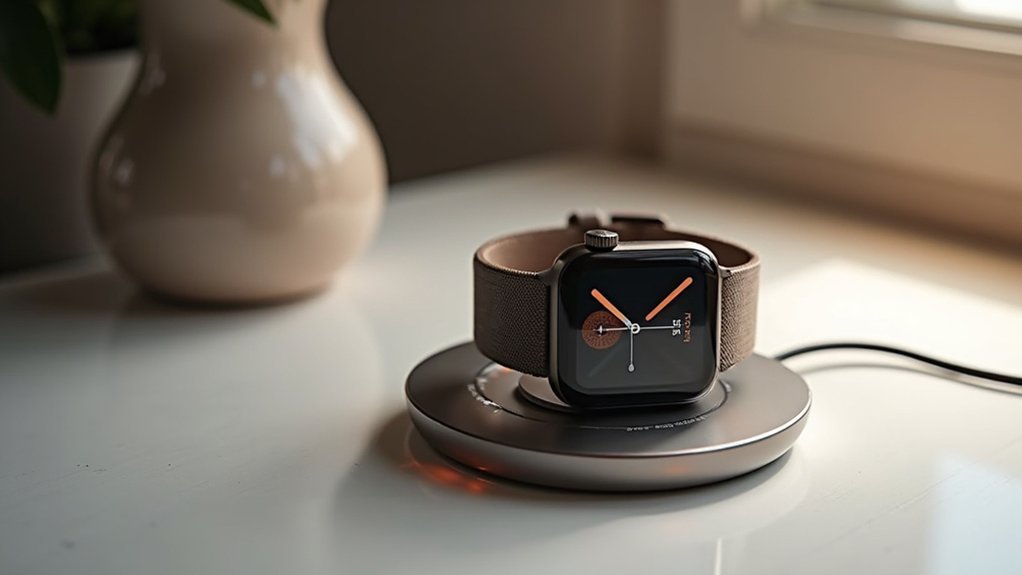
While wireless charging continues to evolve, magnetic dock technology offers one of the most reliable charging solutions for smartwatch users today. These docks use direct magnetic contact to transfer power efficiently to your smartwatch.
Magnetic dock charging combines reliability with efficiency, making it the preferred power solution for discerning smartwatch owners.
You’ll find magnetic docks compatible with various models including Fossil Gen series and Apple Watch. They work through a simple principle: when you place your watch on the dock, magnetic suction secures it in position, creating a stable connection that prevents accidental dislodgement.
Most docks connect to power via USB and feature safety mechanisms to prevent overheating and overcharging. The popular Samsung Galaxy Smart Watch Wireless Charger with its impressive 4.9 star rating demonstrates the reliability consumers expect from these magnetic charging solutions. You can choose from flat charging surfaces, pinned docks for older models, or stand-style options that let you view your watch while it charges.
Their sleek designs often complement your home décor while providing practical functionality.
Qi Wireless Charging: The Universal Standard for Smartwatches
Qi wireless charging offers you the convenience of using a single charging pad for both your phone and compatible smartwatches like the Huawei Watch GT3 Pro.
You’ll appreciate the freedom from proprietary cables as more watch manufacturers adopt this universal standard, allowing cross-brand compatibility between various devices.
Current Qi technology suffers from orientation issues that can make reliable charging more difficult compared to pin-based connections.
While Qi charging brings simplicity to your charging routine, be aware that charging speeds may be slower than with dedicated proprietary chargers designed specifically for your smartwatch model.
Subheading Discussion Points
Despite being widely adopted in smartphones, Qi wireless charging remains surprisingly uncommon in today’s smartwatch market. Most manufacturers opt for proprietary charging solutions, with Huawei’s Watch GT3 Pro being a rare exception offering Qi compatibility.
The small form factor of watches creates significant technical challenges for implementing effective wireless charging.
The introduction of Qi2 in 2023 may change this landscape by addressing three key limitations:
- Alignment issues – New magnetic features similar to MagSafe will improve charging reliability
- Heat management – Advanced thermal regulation for small wearable batteries
- Universal compatibility – Reduced need for multiple chargers while traveling
While proprietary solutions currently dominate, the industry appears to be moving toward standardization that could eventually make Qi charging the norm for smartwatches. Many leading devices like the Samsung Galaxy Watch7 can achieve up to 45% battery in 30 minutes with their manufacturer-specific wireless charging solutions.
Cross-Brand Compatibility Benefits
The benefits of cross-brand compatibility become clear when examining the current proprietary charging landscape. With Qi wireless charging, you’ll reduce clutter and save money by using a single charger for multiple devices. The Qi standard aims to create a universal charging experience that works across brands. Proper alignment is essential as it initiates automatic charging when your device is placed correctly on the charger.
| Brand | Charging Type | Qi Compatible? |
|---|---|---|
| Huawei Watch GT3 Pro | Wireless | Yes |
| Samsung Galaxy Watch | Wireless/USB | Limited |
| Apple Watch | Magnetic | No (needs adapter) |
| Garmin vivomove Trend | Wireless | Yes |
| Fossil | Magnetic | No |
While adoption remains limited due to proprietary systems and technical challenges like heat regulation and coil size, the upcoming Qi2 standard promises improved reliability through magnetic alignment. This could transform the smartwatch charging landscape, making cross-compatibility the norm rather than the exception.
Charging Speed Limitations
While wireless charging brings convenience to smartwatch users, it comes with significant speed drawbacks compared to wired alternatives. Your smartwatch charges slower wirelessly due to the inherent 40% energy loss during transfer, with much of this wasted energy converting to heat.
The compact design of smartwatches further complicates charging speed:
- Small batteries with limited heat dissipation capabilities restrict the power they can safely receive.
- Manufacturers intentionally limit charging rates to prevent overheating that would damage battery cells.
- Imprecise alignment on traditional Qi pads reduces efficiency and extends charging time.
Many Qi-certified chargers implement temperature regulation systems that automatically adjust charging speeds to prevent excessive heat build-up during the charging process.
The upcoming Qi2 standard promises improvements through magnetic alignment, but until widely adopted, you’ll need to accept the tradeoff of convenience versus charging speed when using wireless options.
Proprietary Charging Solutions From Major Brands
While Qi charging offers standardization, major smartwatch brands often implement their own proprietary solutions that lock you into specific accessories.
Apple’s magnetic charging system creates a secure connection but isn’t compatible with regular wireless chargers you might already own.
Samsung provides more flexibility with their wireless docks that support both their watches and Qi standard devices, though you’ll still need to invest in brand-specific accessories for ideal charging performance. These proprietary systems typically require users to ensure proper pin alignment for effective charging results.
Proprietary Charging Solutions From Major Brands
Major smartwatch manufacturers have developed their own proprietary charging technologies to differentiate their products and enhance user experience.
Samsung extends Qi wireless charging to deliver up to 15W of power, while Fitbit utilizes custom cradles that perfectly match their devices’ unique curvatures.
These proprietary solutions offer several advantages:
- Enhanced efficiency – Samsung and Huawei’s fast wireless charging delivers more power than standard options, reducing charging times.
- Better protection – Garmin’s clip-style docks preserve water resistance by eliminating exposed charging ports.
- Improved alignment – Magnetic mechanisms in Samsung watches and Fitbit cradles guarantee perfect positioning for ideal power transfer.
Most proprietary systems sacrifice universal compatibility for speed, security, and reliability—a tradeoff manufacturers believe improves overall user experience. This lack of standardization creates electronic waste and increases consumer inconvenience when finding compatible chargers.
Apple’s Magnetic Charging System
Among proprietary smartwatch charging technologies, Apple’s Magnetic Charging System stands out as one of the most sophisticated approaches in the industry.
You’ll find no exposed contacts in this sealed inductive system, which uses integrated magnets to automatically align and snap the charger to your Apple Watch’s back.
Unlike standard Qi wireless chargers used for smartphones, your Apple Watch requires Apple’s proprietary magnetic connector.
When connected, you’ll see a green lightning bolt confirming successful charging, and you can use Nightstand Mode to display time while charging. The design eliminates the need for precise alignment when placing your watch on the charger.
For added convenience, the MagSafe Duo Charger lets you power both your iPhone and Apple Watch simultaneously.
Apple Watch Series 7 and newer models support fast charging when using the USB-C cable option.
Samsung’s Wireless Docks
Samsung’s wireless charging ecosystem offers a range of proprietary solutions tailored specifically for Galaxy wearables. Their lineup includes flat magnetic docks for newer Galaxy Watch models and cradle-style chargers for older versions—each designed to eliminate cable hassle while ensuring peak charging contact.
For Samsung users with multiple devices, consider these versatile options:
- Multi-device stations – Charge your Galaxy phone, watch, and buds simultaneously on one elegant dock with customized power outputs for each device.
- Wireless PowerShare – Use compatible Galaxy phones as emergency chargers for your watch when you’re away from outlets.
- Model-specific cradles – Specialized solutions like the Fit2 charging cradle enhance charging for unique form factors. The Galaxy Watch Wireless Charging Dock (EP-YO805) features a compact design that fits easily on any nightstand or desk.
Each solution integrates seamlessly into Samsung’s ecosystem, reflecting their commitment to proprietary charging technology.
Solar-Powered Smartwatches: Harnessing Light for Battery Life
While traditional smartwatches require frequent charging via cables, solar-powered alternatives offer a compelling solution by converting light into electrical energy. These devices integrate solar panels into their dials without sacrificing aesthetics, storing generated power in rechargeable batteries. Casio’s Tough Solar system generates power for all functions including measurements, connectivity features, and alarms without requiring battery replacement.
The benefits are substantial—many models can operate for months on a single charge, with some achieving virtually unlimited battery life with just three hours of daily sunlight exposure. You’ll appreciate the reduced maintenance as you’ll rarely need to manually recharge your device.
Beyond convenience, you’re making an environmentally responsible choice by reducing e-waste from disposable batteries. Though initially more expensive, brands like Casio and Garmin offer various options that blend sustainability with functionality, providing reliable performance for everyday use.
Motion and Kinetic Energy: Powering Watches Through Movement
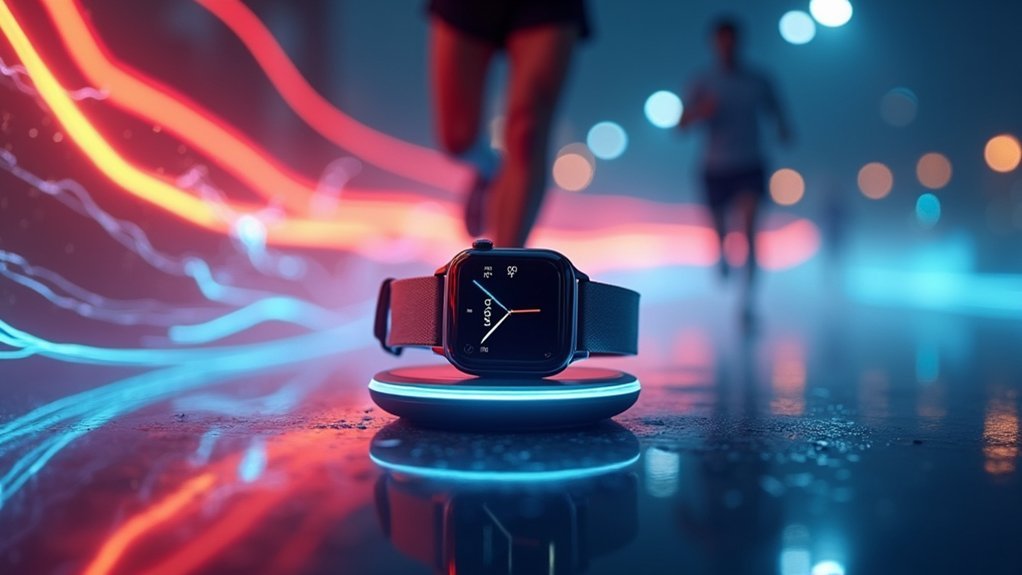
Kinetic smartwatches represent an innovative breakthrough in wearable technology, capturing energy from your everyday movements to power sophisticated functions.
These watches use a rotor system with magnets that move against copper coils, generating electrical current through electromagnetic induction to continuously recharge the battery. Models like the Sequent 2.3 exemplify this technology with their magnetic electricity generator that converts wrist motion into power.
The benefits of kinetic charging include:
- Extended battery life of up to 12 months when not worn, with instant resumption when you put it back on
- Maintenance of full smartwatch capabilities including fitness tracking, heart monitoring, and GPS without sacrificing performance
- Combination of Swiss mechanical durability with modern digital features, emphasizing sustainability over disposability
This technology bridges traditional watchmaking with cutting-edge electronics, eliminating your dependence on charging cables while maintaining precision that exceeds traditional chronometers.
Smartphone-to-Watch Power Sharing Features
You can keep your smartwatch powered while traveling by using your smartphone’s reverse wireless charging capabilities, with Samsung’s PowerShare and iPhone’s power sharing features allowing back-to-back device placement for on-the-go energy transfer.
However, you’ll encounter compatibility limitations when trying to charge across brands, as Samsung’s system works best with Galaxy Watches while iPhones primarily support Apple Watches. Samsung’s PowerShare specifically supports Galaxy Watch series and other Samsung wearables through WPC Qi certification.
To maximize success with this method, you’ll need to align the charging coils properly and remove thick cases that might interfere with the power transfer.
Charging On-the-Go
Modern smartphones offer a revolutionary charging solution that eliminates the need for extra cables when your smartwatch battery runs low.
Samsung’s Wireless PowerShare technology transforms your phone into a portable charging pad for Galaxy Watches and other Qi-compatible devices, perfect for travel emergencies.
To power your watch on the go:
- Enable Wireless PowerShare through your phone’s notification panel
- Align your watch against the back of your phone (remove cases if necessary)
- Wait for the charging indicator to appear on both devices
This feature works with Galaxy S10-S23 series, Note models, and foldable phones.
You’ll appreciate having fewer cables to pack while traveling, and the peace of mind knowing you can transfer power between devices when outlets aren’t available. You can even charge your Galaxy wearables while your phone is simultaneously charging with an authorized charger.
Cross-Brand Compatibility Challenges
While Samsung’s Wireless PowerShare creates a seamless experience within its ecosystem, cross-brand compatibility presents significant challenges for smartwatch users seeking convenient charging solutions.
You’ll find that Samsung watches pair effectively with Samsung phones for wireless charging, but cross-brand watch charging remains limited.
Though Qi certification enables some cross-brand functionality, your smartwatch mightn’t charge properly with phones from different manufacturers. Proper device placement is critical, requiring back-to-back positioning of compatible devices for optimal charging connection. Your phone case could also interfere with the connection, further complicating matters.
Even when compatible, you’ll experience slower charging speeds and reduced efficiency compared to traditional methods.
These limitations stem from brand exclusivity strategies and varying technological standards. As manufacturers continue developing their ecosystems, you might find the convenience of wireless PowerShare restricted primarily to same-brand device pairings, with true cross-brand compatibility remaining an ongoing challenge.
Charging Stands vs. Pads: Form Factors Compared
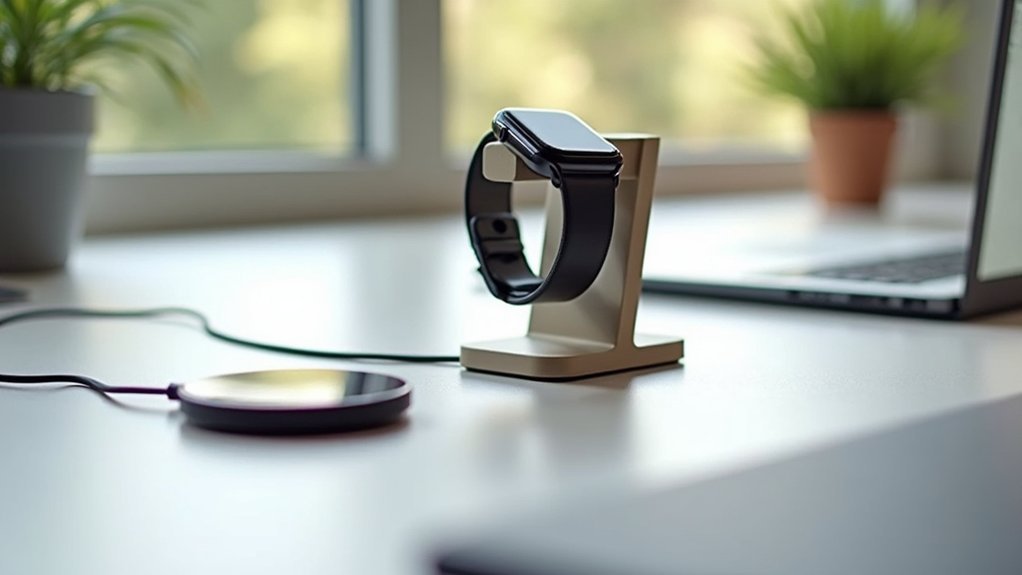
When selecting a smartwatch charging solution, the choice between stands and pads often comes down to practical considerations beyond mere aesthetics.
Stands offer better visibility while charging and typically include adjustable angles for ideal viewing, making them ideal if you frequently check notifications or watch content during charging sessions. Both types require perfect alignment for optimal performance, similar to other wireless charging technologies.
Pads, however, excel in simplicity and space efficiency. They’re typically more affordable and can fit into tighter spaces, making them perfect for travel.
Your decision might depend on:
- Usage habits – Do you need to view your watch while charging?
- Space constraints – Is vertical or horizontal space more valuable to you?
- Multi-device needs – Some pads charge multiple devices simultaneously, while stands often focus on a single device.
Fast Charging Technologies for Modern Smartwatches
As battery life remains a limiting factor for smartwatches, manufacturers have developed impressive fast charging technologies to compensate.
Apple Watch Series 7 charges 33% faster than previous models, reaching full capacity in just 75 minutes with specialized chargers like Belkin’s BoostCharge Pro.
Fossil’s Gen 6 leverages the Snapdragon Wear 4100+ platform to achieve 80% charge in about 30 minutes—twice as fast as earlier generations.
Meanwhile, Samsung’s Galaxy Watches utilize Qi wireless technology for cable-free convenience.
Armitron’s Matrix Smartwatch incorporates magnetic rapid charging capabilities that align perfectly with its focus on user convenience and minimizing downtime.
These advances aren’t just about speed. Targeted power delivery algorithms, improved thermal management, and adaptive charging profiles help preserve battery health while minimizing downtime.
Most fast charging systems cap rapid charging at 80% to protect battery chemistry, then slow down to complete the final 20%.
Battery-Extending Charging Methods for Outdoor Adventures
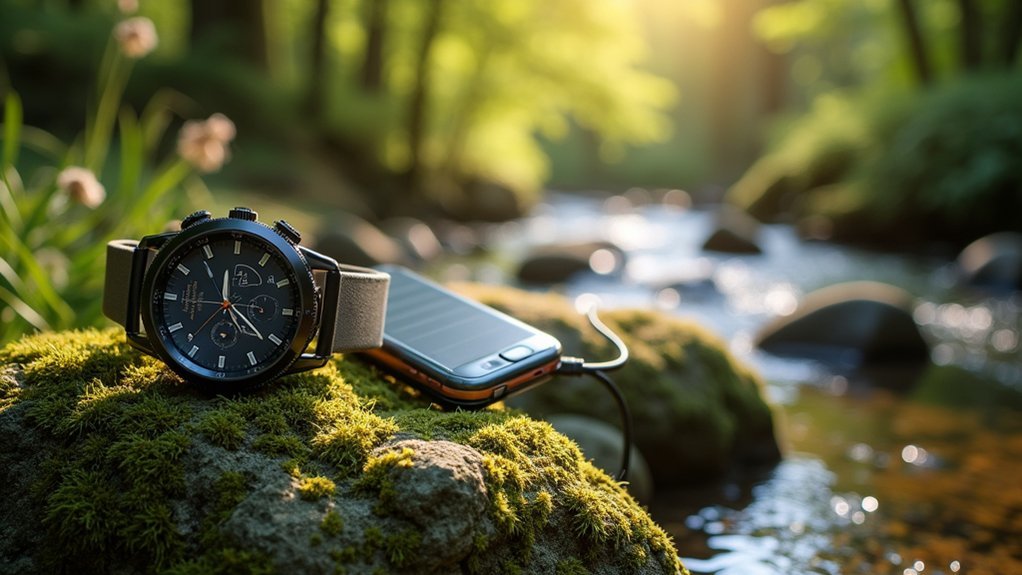
For outdoor enthusiasts who venture far from power outlets, traditional charging methods simply won’t suffice.
Solar charging technology harnesses sunlight through photovoltaic cells, steadily replenishing your battery during daylight hours. Brands like Garmin have integrated this feature specifically for endurance activities.
When exploring the wilderness, consider these alternative power solutions:
- Kinetic charging systems that convert your body movement into electrical energy, providing continuous trickle charging during hikes and runs.
- Portable wireless charging pads paired with power banks, eliminating cable hassles while offering flexible charging opportunities.
- Multi-functional hybrid chargers that combine solar, kinetic, and other technologies for reliable power in diverse environments.
Don’t forget to optimize battery management by disabling non-essential features like haptics and always-on displays. Keep your watch at a cooler temperature while charging in outdoor environments to protect battery health and maximize charging efficiency.
Charging on the Go: Portable Solutions for Travelers
Travelers who depend on their smartwatches face unique charging challenges while guiding through airports, hotels, and varying international power standards.
Multi-device wireless charging stations offer a clutter-free solution, powering your smartwatch, phone, and earbuds simultaneously in a foldable, compact design. Products like the EVOLVED® Fold Pro eliminate cable clutter with its 3-in-1 design while supporting fast charging for all your devices.
For a more minimalist approach, magnetic USB-C charging cables provide secure attachment without bulk—easily fitting in your pocket.
Dedicated travel chargers with collapsible designs support fast charging while taking minimal space in your carry-on.
Alternatively, lightweight charging docks double as stands, working with power banks or airplane USB ports.
For maximum flexibility, pair your charging solution with a multi-port power bank or universal travel adapter, ensuring your smartwatch stays powered whether you’re off-grid or guiding through different outlet standards internationally.
Future Innovations: Emerging Smartwatch Charging Technologies
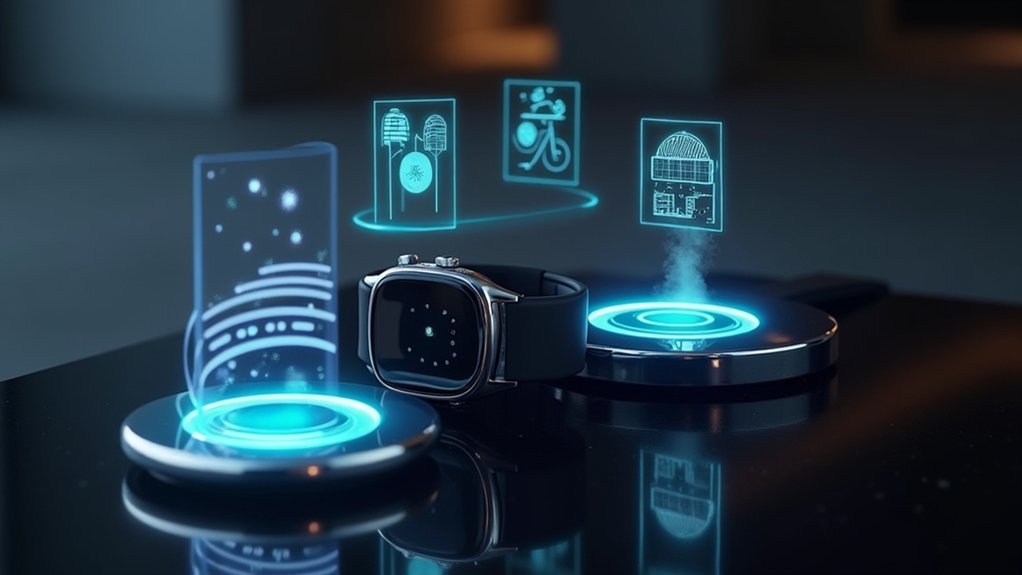
Innovations in smartwatch charging technology promise to revolutionize how you power your wearable devices in the coming years.
You’ll soon experience wireless charging speeds up to 50W and benefit from the enhanced compatibility of Qi 2.0 across multiple devices.
Energy harvesting technologies will transform your charging routine:
- Long-range wireless charging will power your smartwatch from across the room without requiring contact with a charging pad.
- Kinetic energy capture will convert your daily movements into power, reducing battery dependence.
- Smart materials will manage heat during fast charging while extending your device’s lifespan.
Expect modular designs that facilitate easier maintenance and magnetic alignment systems that guarantee perfect placement every time you charge your smartwatch.
The growing adoption of sealed designs in wearables makes wireless charging especially valuable for waterproof smartwatches.
Environmental Impact of Different Charging Methods
While you enjoy the convenience of powering your smartwatch, each charging method carries distinct environmental implications that extend far beyond your wrist. Your charging choices directly influence energy consumption, waste generation, and device longevity. Many of these charging technologies contribute to the growing e-waste generation when devices become obsolete or difficult to repair.
| Charging Method | Environmental Benefits | Drawbacks | Sustainability Rating |
|---|---|---|---|
| Energy Harvesting | Reduces grid reliance, extends battery life | Limited power generation | High |
| Wireless Charging | Eliminates cable waste | Standby power consumption, lower efficiency | Medium-Low |
| Solar Charging | Uses renewable energy, promotes autonomy | Weather-dependent | High |
| Traditional Wired | Highest energy transfer efficiency | Cable waste, grid dependency | Medium |
Frequently Asked Questions
Can Smartwatches Charge From Standard USB Ports Without Adapters?
Most smartwatches can’t charge directly from standard USB ports without adapters. You’ll typically need proprietary charging docks or cables, though some budget models with micro-USB ports are exceptions to this rule.
How Do Water-Resistant Smartwatches Maintain Charging Functionality?
Water-resistant smartwatches maintain charging functionality through sealed ports with rubber gaskets, magnetic charging docks, or wireless charging. You’ll find they use corrosion-resistant contacts and hydrophobic coatings to protect electrical components while allowing power transfer.
Do Smartwatch Chargers Work With Protective Cases Installed?
Most smartwatch chargers work with thin, non-metallic cases (under 3mm), but you’ll likely experience slower charging speeds. For peak performance, you should remove your case or choose one specifically designed for charging compatibility.
Can Charging Methods Affect Smartwatch Battery Longevity?
Yes, your charging methods directly impact battery longevity. Fast wired charging generates more heat that degrades batteries faster, while slower wireless charging is gentler. You’ll extend battery life by keeping charges between 20-80% regardless of method.
Are There Charging Options for Discontinued Smartwatch Models?
For discontinued smartwatches, you’ll find options through third-party adapters, vintage marketplaces like eBay, DIY modifications, and converter cables. Magnetic dock alternatives and universal wireless chargers sometimes work with older models too.
In Summary
You’ve seen the diverse world of smartwatch charging beyond traditional cables, from magnetic docks to solar power and kinetic energy solutions. As technology evolves, you’ll find more convenient and eco-friendly options emerging. Consider your lifestyle when choosing—whether you’re an outdoor enthusiast, frequent traveler, or eco-conscious consumer. The future of smartwatch charging isn’t just about convenience—it’s about sustainability and seamless integration into your daily life.

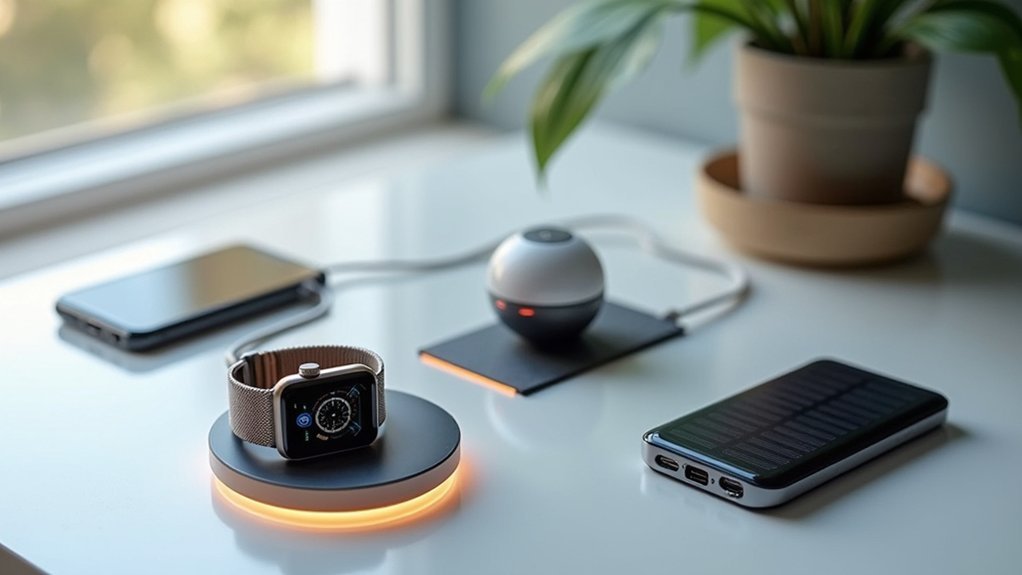



Leave a Reply